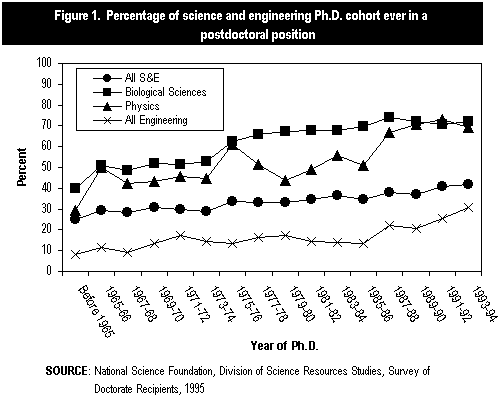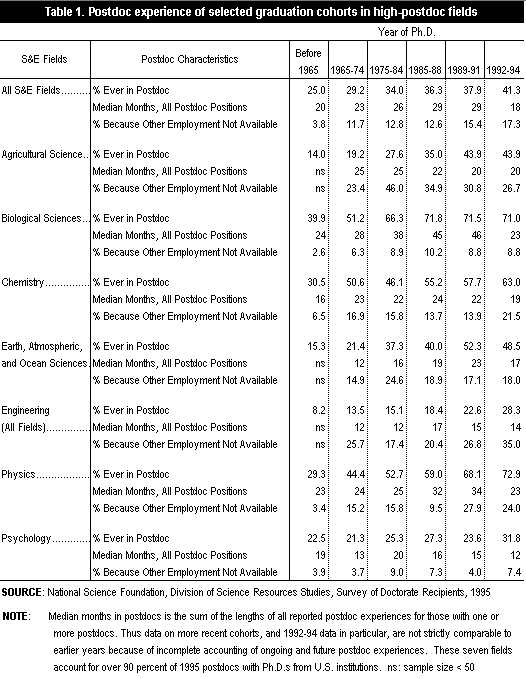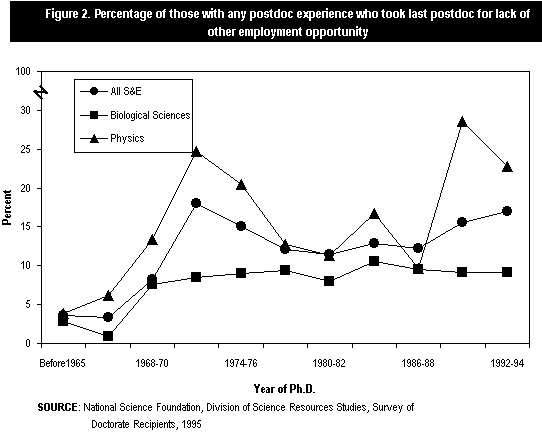
Directorate for Social, Behavioral
and Economic Sciences
NSF 99-310 December 2, 1998

Both the percentage of S&E Ph.D.s ever in a postdoc and the median length of time spent in postdocs have risen over time.
Only 17 percent of 1995 postdocs reported that they were in postdocs because other employment was not available.
A postdoctoral appointment, or "postdoc," has traditionally been defined as a temporary position, after completion of a doctorate, taken primarily for additional training-a period of advanced professional apprenticeship. More recently, however, there are reports that new Ph.D.s are turning to postdocs not primarily for training, but as a form of low-pay[1] employment while waiting for a more permanent professional position. This issue brief examines the self-reported postdoc histories of holders of science and engineering Ph.D.s from U.S. schools to address the question whether the use of postdocs has changed.
Postdocs Are an Increasingly Common Experience
About 42 percent of all U.S. science and engineering (S&E) Ph.D.s who
received their degrees in 1993-94 reported having a current or former
postdoctoral appointment by April 1995. The percentage of all S&E Ph.D.s
who ever had a postdoc position has risen across graduation cohorts for
at least three decades, from 25 percent for the 1965-66 graduation cohort
to 42 percent for the 1993-94 cohort (figure 1).
Also shown in figure 1 are the postdoc rates for Ph.D. cohorts in the two fields with the highest rate of postdoc use, biological sciences and physics, as well as the aggregate for all engineering fields. Both the biological sciences and physics showed robust increases of postdoc use since the 1965-66 Ph.D. cohort: biological sciences from 51-72 percent, physics from 50-69 percent. Postdocs are notably gaining in importance for Ph.D.s in engineering fields. Postdoc use for engineering Ph.D.s went from 12 percent of 1965-66 Ph.D.s to 31 percent of the 1993-94 cohort. Seven fields, which together accounted for over 90 percent of all S&E postdoctorates in 1995, all showed a similar pattern of increasing postdoc use (table 1).
Is Increased Use of Postdocs Due to Labor Market Conditions?
In general, the growth of postdoc use has been too steady over the last
thirty years to attribute this development to short-term changes in labor
market conditions. Physics may represent a possible exception: increases
in postdoc use followed the end of the Vietnam War (1975-76 cohort) and
the Cold War (1987-88 cohort). These two events may well have had particular
employment effects in physics. In the biological sciences, postdoc use
peaked at 74 percent for the 1987-88 cohort, but since a few postdocs
are taken in mid-career, the later graduation cohorts may eventually exceed
this rate.
More Time is Spent in Postdoctoral Appointments
The length of time S&E Ph.D.s spent in postdocs has also increased over
time. Half of the postdocs whose doctorates were earned before 1965 spent
20 or fewer months in that type of appointment. For those in the 1989-91
graduation cohort, this figure (the median) had risen to 29 months, and
6 percent of them were still in postdoc positions by April, 1995. Although
additional time could be spent in a postdoc at any point in an individual's
career, estimates for members of the 1992-94 graduating cohort (18 months
in postdocs) are noticeably lower because 25 percent were still in postdoc
positions. This median number for all S&E fields combined will inevitably
rise, as some of these appointments continue (table
1).
The increase in median length of postdoc experience was greatest in the biological sciences-rising from 24 months for the pre-1965 cohort to 46 months for the 1989-91 cohort. However, for some fields-agricultural sciences, chemistry, and psychology-median postdoc length stayed roughly the same or even declined somewhat for Ph.D.s graduating after 1965. Postdocs in engineering fields remain relatively short, reaching only 17 months for the 1985-88 cohort.
Postdoc Positions For Want of More Desirable Employment?
Those with postdoctoral appointments are asked to report their reasons
for accepting this position; one choice is "other employment not available."
The share who selected this choice as the reason for their final postdoc
appointment peaked at 20 percent for the 1971-72 graduation cohort, declined
in the 1970's, and has been rising again slowly for those graduating since
the early 1980's[2] (table
1 and figure 2).
Trends in the use of postdocs as employment-of-last-resort differ greatly by field. In physics, it has varied greatly over time with approximate peaks for the 1971-73 (25 percent) and 1989-91 (29 percent) graduation cohorts. But in the biological sciences, "other employment not available" was reported by only around 10 percent of each graduation cohort over the last 20 years. In the other major postdoc fields (agricultural science; earth, atmospheric and ocean sciences; and in psychology) the highest reported rates occurred in the late 1970's or early 1980's.
Most respondents report reasons for accepting postdoctoral appointment that are consistent with the more explicit purposes of the position, such as advanced training in their field, training outside their field, or working with a specific person. On the other hand, reporting that no other job was available may be a difficult step for some respondents. The data reported here suggest, however, that the rise in the number of postdoctoral appointments is not mainly due to insufficient other employment opportunities.
This Issue Brief was prepared by:
Mark C. Regets
Division of Science Resources Studies
National Science Foundation
4201 Wilson Boulevard, Suite 965
Arlington, VA 22230
703-306-1776 ext. 6923
E-mail: mregets@nsf.gov
SRS data are available through the World Wide Web (http://www.nsf.gov/statistics/). For more information about obtaining reports, contact pubs@nsf.gov. or call (301) 947-2722. For NSF's Telephonic Device for the Deaf, dial (703) 306-0090. In your request, include the NSF publication number and title, your name, and a complete mailing address.


